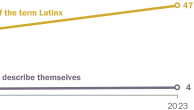The Census Bureau presents new research tomorrow that attempts to address the frequent mismatch between Americans’ self-identity and the race or Hispanic categories they are offered on their census questionnaires. The issue is especially important for counting Hispanics, the nation’s largest minority group.
Currently, Americans are asked separate questions about origin and race. The 2010 Census form first asked people whether they are of Hispanic origin (and, if so, which origin). Then, all respondents were asked to check one or more of the boxes assigned to the five race categories (white, black, American Indian, Asian, or Hawaiian/Pacific Islander). The form noted, “For this census, Hispanic origins are not races.” The race and Hispanic origin categories are set by the Office of Management and Budget, and the last major revision was in 1997.

But these categories do not always match people’s ideas of who they are. Despite the Census Bureau’s hopes that respondents would select from the offered race categories, more than 19 million people in the 2010 Census chose a catch-all category, “some other race.” The number and share of the population choosing “some other race” grew since the 2000 Census.
Most of those who chose “some other race” were Hispanic. This mismatch between the categories and the choices that Hispanics make on their census forms is growing in part because the Hispanic population is increasing rapidly. Yet government officials want people to choose from the offered categories because they are widely used, not just on the census form, but also in many federal surveys, on government forms such as school registrations, and in scientific research. Race data collected in the census are used to support enforcement of civil rights laws and redistricting of congressional districts.
There also are other issues with the race categories used on the census form. For example, some respondents objected to the word “Negro,” which was one of the choices on the 2010 Census form along with “black” or “African American.” Some groups would like a separate category for those of Arab descent. There is not a specific category for the growing number of indigenous people from Latin America.
Census forms through the decades have employed a changing list of race categories that reflect their times, and the government did not even attempt to count Hispanics until late in the 20th century. The attempt to classify people by race or origin is by nature an imperfect enterprise. As the Office of Management and Budget acknowledged in 1997, the race categories “represent a social-political construct designed for collecting data on the race and ethnicity of broad population groups in this country, and are not anthropologically or scientifically based.”
The research to be reported tomorrow is part of a broad Census Bureau program intended to improve the accuracy of census data. In this case, the Census Bureau experimented with alternative questionnaire design and question wording in the quest for improved responses to the race and origin questions. The research included mailing 15 alternative types of Census 2010 forms to 30,000 households each, a telephone survey of a sample of those respondents and a wide variety of focus group interviews on the general topic of self-identification.
A variety of changes were included on the experimental alternative questionnaires, but the major innovation tested was to combine race and Hispanic origin into a single question: “What is Person 1’s race or origin?” The instructions tell respondents to mark one or more boxes. The respondent is told to write in the specific race(s) or origin(s), either as part of that question or in a second follow-up question. The bureau already has signaled that it intends to follow up with more research on this combined question.




